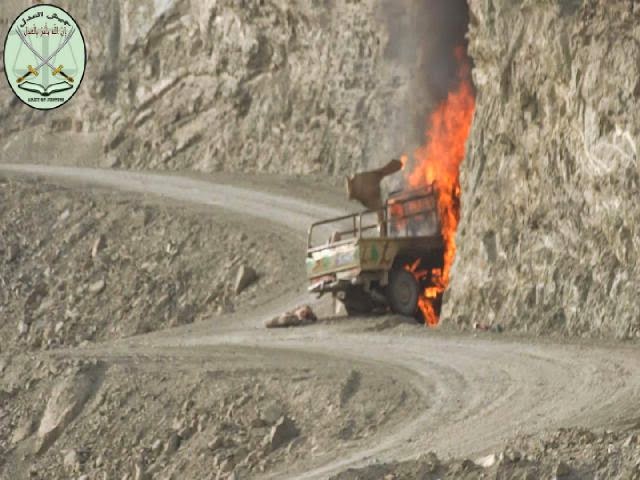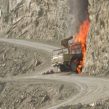
Iran Confronts Intensifying Insurgent Offensive in Sistan-Balochistan Province
Publication: Terrorism Monitor Volume: 13 Issue: 8
By:

While diplomatic developments between Iran and the United States over Iran’s nuclear program and Iran’s actions in countries such as Syria and Yemen have drawn the most attention in recent weeks, a series of attacks in Iran’s southeastern Sistan-Balochistan province underline that a range of ethnic Baloch militant factions continue to wage a bloody insurgency there. Iran frequently blames hostile outside powers, including the United States, Saudi Arabia, the United Kingdom and Israel, among others, of supporting the ethnic Baloch insurgency and other violent opposition factions operating in the country. Yet a combination of factors, including the region’s political and economic marginalization, an array of ethnic and religious grievances derived from the ethnic Baloch and largely Sunni faith of its inhabitants against what is perceived as an exclusionary and repressive ethnic Persian-centric Shi’a government and the spread of Sunni extremist ideologies has provided a fertile atmosphere for armed insurrection.
Latest Attacks
In one incident, on April 6, eight Iranian border police officers were killed and another was wounded when they were ambushed by Jaysh al-Adl (JAA—Army of Justice), an ethnic Baloch militant group that is believed to have emerged sometime in 2012. The attack occurred in the town of Negur, near the Iran-Pakistan border (al-Arabiya [Dubai], April 7). The group broadcasted its claim of responsibility along with alleged photographs of the aftermath of the attack—including images of a smoldering military pickup truck and a motorcycle—on its network of social media platforms, such as its official blogs and Twitter account (Edaalat News, April 7; JashulAdl3, April 7). [1] The announcement was followed by the April 11 posting of what JAA claims to be video footage of the attack on its affiliated YouTube page (YouTube, April 11). Iranian officials meanwhile reported that the militants retreated into Pakistani territory after the attack. This is the single-most deadly attack on Iranian security forces in Sistan-Balochistan since an October 2013 JAA attack killed 14 border police officers at a border checkpoint in the town of Rustak, just outside of Saravan, close to the Iran-Pakistan border (Dawn [Karachi], April 8). In another recent incident, JAA announced on April 9 that it had killed two signals intelligence officers associated with Iran’s Islamic Revolutionary Guard Corps (IRGC) in Sistan-Balochistan’s Mehrestan region in the east-central part of the province (Press TV [Tehran], April 9). A claim of responsibility, along with graphic photographs of what JAA alleges are the remains of the dead IRGC officers, was again disseminated via JAA’s official social media outlets (Edaalat News, April 9; JashulAdl3, April 9).
JAA’s attack occurred shortly following an April 6 announcement by Iranian officials that the IRGC had disrupted a militant cell based in Qasr Qand in the southeast part of Sistan-Balochistan. The operation was reported to have resulted in the deaths of three militants. Two other militants were injured and scores of others were arrested. A sizeable cache of arms and explosives was also reportedly uncovered at the scene. While Iran has not publicized the identity of the militant faction, they have accused it of acting at the behest of enemy foreign intelligence services (Tasnim News Agency [Tehran], April 7; Fars News Agency [Tehran], April 6). While the operation that targeted the Iranian border police officers was claimed by JAA, some early reports attributed the attack to Ansar al-Furqan (AF—Partisans of the Criterion), another ethnic Baloch insurgent faction that is likewise engaged in a campaign of violence against the Islamic Republic. AF also claimed to have shot down an Iranian military helicopter operated by the Basij paramilitary forces around Qasr Qand. Video footage that allegedly showed the downed helicopter was broadcast on AF’s numerous social media platforms, including via its official Twitter account @ANSAR_ALFURQAAN, on April 9 (Twitter, April 9). The dissemination of the footage coincided with the recirculation of a video statement by AF spokesman Abu Hafs al-Balochi that appears to have been previously broadcast in February that reaffirmed AF’s determination to wage war against Iran (YouTube, February 6). The wave of attacks against Iranian forces in Sistan-Balochistan also occurred against the backdrop of an announcement in March by Pakistan that it had detained ranking ethnic Baloch militant commanders in Quetta, the provincial capital of Pakistani Balochistan. Iran has demanded that Pakistan transfer the detainees to its custody (Express Tribune [Karachi], March 9; Pakistan Today [Lahore], March 1).
Mapping the Militants
The multiplicity of armed factions that are waging a campaign of violence and terrorism against Iranian security forces and other displays of Iranian rule in Sistan-Balochistan draw direct inspiration or are otherwise linked through familial and tribal ties to the now defunct Jundallah group, and its late founder and leader Abdelmalek Rigi. [2] The capture of Rigi by Iranian security forces in February 2010, and his subsequent execution in the same year, appeared to temporarily dampen the ethnic Baloch insurgency. However, the disruption of Jundallah would eventually give rise to a host of other armed detachments composed of former Jundallah members and followers that appear to maintain tangential, if not direct, operational linkages. As evidenced by the symbolism and discourse adopted by militant factions such as JAA, AF—which itself emerged following the 2013 merger of ethnic Baloch factions Harakat Ansar Iran (HAI—Movement of the Partisans Iran) and Hizb al-Furqan (HAF, Party of the Criterion)—the Rigi surname is a recurring theme in the annals of ethnic Baloch militancy in Sistan-Balochistan (Ansarirana, December 5, 2013). In addition, while the precise identity of the ethnic Baloch militant that is currently being held in Pakistan is unclear, there appears to be a direct link to the late Rigi. For example, Iran has requested that Abdel Sattar Rigi, a purported brother of the late Jundallah commander and alleged leader of Jaysh al-Nasr (JAN—Army of Victory), another ethnic Baloch militant group based in Sistan-Balochistan, be extradited to Iran. Yet Pakistan claims that it has instead detained Abdel Salam Rigi, a ranking member of JAA and cousin of the late Jundallah leader (Express Tribune [Karachi], March 9). The prominence of the Rigi family in ethnic Baloch militancy in Sistan-Balochistan has not been lost on Iran. Jundallah and its progeny are frequently referred to as the “Rigi Clan.” In addition, JAA and AF also identify Sipah-e-Sahaba Iran (SSI—Guardians of the Companions Iran), another obscure extremist faction based in Sistan-Balochistan, as an ally in their campaign against the Islamic Republic, further indicating the loose links between these groups.
Background to Rebellion
A key factor driving the insurgency in Sistan-Balochistan is the character of Iran’s state-periphery dynamics and the position occupied by ethnic and religious minorities in the country. Life in Sistan-Balochistan, where the majority of Iran’s ethnic Baloch minority of around 3 million resides—Sistan-Balochistan is sometimes referred to as Iranian Balochistan—is characterized by poverty, underdevelopment and oppression. Sistan-Balochistan’s location adjacent to Pakistan and Afghanistan also puts it in the middle of one of the world’s most dangerous drug, arms and human trafficking corridors, which has also exposed the region’s population to the overbearing presence of Iranian security forces. Their status as an ethnic minority in Iran’s ethnically and culturally Persian-dominated society is further amplified by their largely Sunni affiliation within Iran’s Shi’a Islamist theocratic state. Emblematic of this situation is that Jundallah initially touted itself as a defender of ethnic Baloch rights alongside other oppressed ethnic and religious communities in Iran. However, it would eventually adopt an overtly sectarian-infused narrative that emphasized hardline Salafist and similarly extremist perspectives. This included concepts echoed in the ideologies and discourse propagated by al-Qaeda and its regional affiliates and the Taliban in Afghanistan and Pakistan, particularly explicit anti-Shiism; hardline Salafists tend to consider Shi’a Muslims as heretics and apostates and the Islamic Republic as a wellspring of Shi’a dogma. Jundallah’s eventual resort to suicide bombings—a tactic that has become a regular feature of ethnic Baloch militancy in recent years—has hinted at the influence of al-Qaeda-style extremism within the large milieu of the ethnic Baloch opposition. Indeed, the nature and tone of the messaging and symbolism used by the current generation of ethnic Baloch extremists leave little doubt of the centrality of hardline Salafist principles to their campaign against Iran. For instance, AF often refers to Iran’s rulers (and Shi’a believers in general) as rafidah (rejectionists), a pejorative label ascribed to Shi’a Muslims by Sunni extremists (YouTube, February 6).
Outlook
The progressively sectarian-tinged regional atmosphere combined with the wider geopolitical dynamics illustrated by the competition between Iran and Saudi Arabia will likely catalyze further displays of violence in Sistan-Balochistan by an increasingly emboldened insurgency. The potential second-order impacts of the withdrawal of U.S. forces from Afghanistan coupled with growing instability in Pakistan, including in Pakistan’s own Balochistan province, where there is also a long-running Baloch insurgency, will also continue to shape the course of developments in Sistan-Balochistan in the months ahead.
Chris Zambelis is a Senior Analyst specializing in Middle East affairs for Helios Global, Inc., a risk management group based in the Washington, D.C. area. The opinions expressed here are the author’s alone and do not necessarily reflect the position of Helios Global, Inc.
Note
1. JAA’s Twitter account can be found at https://twitter.com/ArmyOJustice.
2. For a more detailed treatment of the evolving landscape of ethnic Baloch militancy in Iran, see Chris Zambelis, “The Evolution of the Ethnic Baloch Insurgency in Iran,” CTC Sentinel, Vol. 7, Issue 3, March 26, 2014, https://www.ctc.usma.edu/posts/the-evolution-of-the-ethnic-baluch-insurgency-in-iran.





